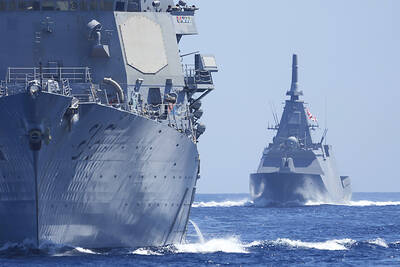The worldwide arms race has accelerated, most dramatically in South America and Southeast Asia, despite the economic and financial slump, a report published yesterday said.
The average volume of arms sales increased by 22 percent over the past five years, compared with the previous five-year period, the report by the Stockholm International Peace Research Institute (SIPRI) says.
The last two of these years were marked by worldwide economic turbulence, which has far from stabilized, yet the arms trade is booming, it found.
The report does not give the cost of the arms trade because most governments no longer release the figures. Britain stopped publishing the cost of its arms sales last year.
The US remains the world’s top arms exporter, accounting for 30 percent of the total, followed by Russia (23 percent), Germany (11 percent) and France (8 percent).
Britain, with 4 percent, saw a fall in the volume of its exports, as the delivery of 72 of its Eurofighter Typhoon aircraft to Saudi Arabia was only just getting under way in the period covered by the report.
Germany’s arms exports have risen by more than 100 percent, mainly because of sales of armored vehicles, the report said.
Arms sales to South America rose by 150 percent, raising the specter of an arms race in the region. Last year Venezuela received US$2.2 billion in credit from Russia for the purchase of air defense systems, artillery, armored cars and tanks.
“We see evidence of competitive behavior in arms acquisitions in South America. This clearly shows we need improved transparency and confidence-building measures to reduce tension in the region,” said Mark Bromley, SIPRI researcher and Latin America expert.
In Southeast Asia, arms sales to Indonesia and Malaysia increased significantly, while Singapore became the first country in the region to be among the world’s top 10 arms importers, since the end of the Vietnam war.
“In 2009, Vietnam became the latest Southeast Asian state to order long-range combat aircraft and submarines,” SIPRI Asia expert Siemon Wezeman said.
“The current wave of acquisitions could destabilize the region, jeopardizing decades of peace,” he said.
China was the world’s biggest arms importer over the past five years, with 9 percent of the total, followed by India, South Korea, the United Arab Emirates and Greece, traditionally a big weapons importer and now immersed in a serious economic crisis.
Combat aircraft accounted for 39 percent of major US weapons sales over the past five years, and for 40 percent of Russian arms sales, the report said.
The report also warns that deliveries of combat aircraft could fuel an arms race in the Middle East, North Africa, South America and South Asia.
Meanwhile, Pakistan is importing the first batch of 300 combat aircraft from China and an early warning aircraft from Sweden.

A fire caused by a burst gas pipe yesterday spread to several homes and sent a fireball soaring into the sky outside Malaysia’s largest city, injuring more than 100 people. The towering inferno near a gas station in Putra Heights outside Kuala Lumpur was visible for kilometers and lasted for several hours. It happened during a public holiday as Muslims, who are the majority in Malaysia, celebrate the second day of Eid al-Fitr. National oil company Petronas said the fire started at one of its gas pipelines at 8:10am and the affected pipeline was later isolated. Disaster management officials said shutting the

US Vice President J.D. Vance on Friday accused Denmark of not having done enough to protect Greenland, when he visited the strategically placed and resource-rich Danish territory coveted by US President Donald Trump. Vance made his comment during a trip to the Pituffik Space Base in northwestern Greenland, a visit viewed by Copenhagen and Nuuk as a provocation. “Our message to Denmark is very simple: You have not done a good job by the people of Greenland,” Vance told a news conference. “You have under-invested in the people of Greenland, and you have under-invested in the security architecture of this

UNREST: The authorities in Turkey arrested 13 Turkish journalists in five days, deported a BBC correspondent and on Thursday arrested a reporter from Sweden Waving flags and chanting slogans, many hundreds of thousands of anti-government demonstrators on Saturday rallied in Istanbul, Turkey, in defence of democracy after the arrest of Istanbul Mayor Ekrem Imamoglu which sparked Turkey’s worst street unrest in more than a decade. Under a cloudless blue sky, vast crowds gathered in Maltepe on the Asian side of Turkey’s biggest city on the eve of the Eid al-Fitr celebration which started yesterday, marking the end of Ramadan. Ozgur Ozel, chairman of the main opposition Republican People’s Party (CHP), which organized the rally, said there were 2.2 million people in the crowd, but

JOINT EFFORTS: The three countries have been strengthening an alliance and pressing efforts to bolster deterrence against Beijing’s assertiveness in the South China Sea The US, Japan and the Philippines on Friday staged joint naval drills to boost crisis readiness off a disputed South China Sea shoal as a Chinese military ship kept watch from a distance. The Chinese frigate attempted to get closer to the waters, where the warships and aircraft from the three allied countries were undertaking maneuvers off the Scarborough Shoal — also known as Huangyan Island (黃岩島) and claimed by Taiwan and China — in an unsettling moment but it was warned by a Philippine frigate by radio and kept away. “There was a time when they attempted to maneuver